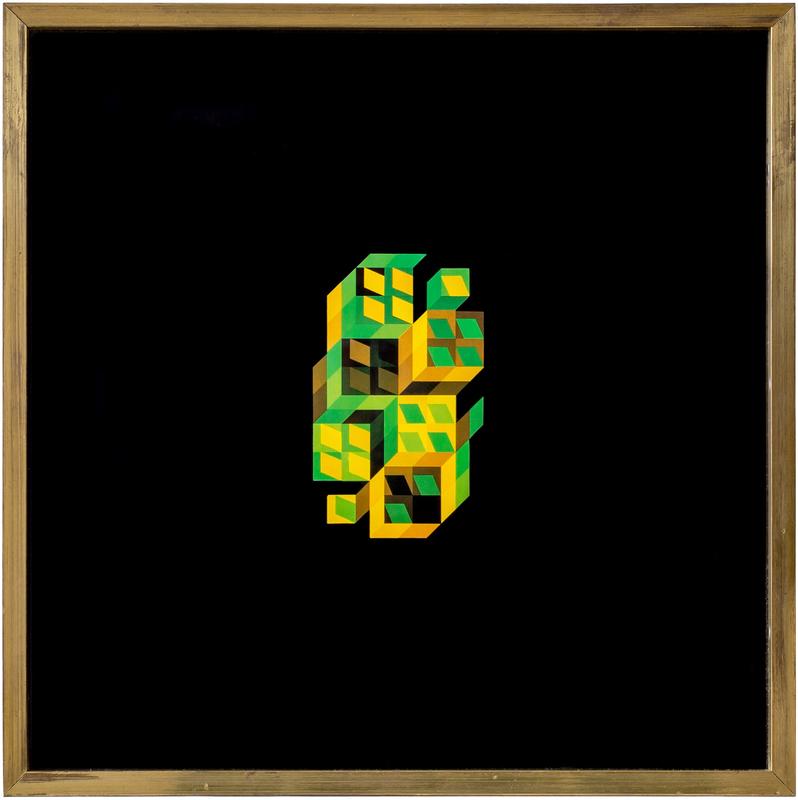Victor Vasarely - (born April 9, 1906, Pécs, Hungary, died March 15, 1997, Paris, France). An outstanding Hungarian-French artist, one of the leading representatives of contemporary art, a precursor of the Op Art movement. The author of a work considered to be the first example of this art - "Zebra" from 1930. The great fame and recognition he gained ensured him a lasting place in history. Initially, he studied medicine at the University of Budapest. After two years, in 1927, he began studying at the Podolini-Volkmann private art school. At the turn of 1928 and 1929, he enrolled in the school of Sándor Bortnyik - a Hungarian painter and graphic artist, to which he promoted the ideas of Bauhaus (this name referred to the arts and crafts school in Weimar and the architectural direction within German modernism, which advocated, among others, functionalism, the combination of technology with art or the significant role of social factors in architecture and design). They had a significant impact on the young artist's work. He then turned his attention to abstract art and constructivism, and the idea of art responding to the needs of industrial society became close to him. In 1929, Vasarel's works "Blue Study" and "Green Study" were created, which were important for his painting. A year later, he married his college friend Claire Spinner and moved to Paris. He started working as a creative consultant and graphic designer at the Havas advertising agency and the popular Draeger printing house. The early graphic period of Victor Vasarely's work dates from 1929 to 1946. It included an interest in kinetic abstraction, perspective, chiaroscuro, and texture. Created at that time, among others: "Girl-Flower" (1934) and "Chess Board" (1935). Landscape motifs and self-portraits appear in the artist's paintings between 1935 and 1947. They were marked by the influence of surrealism and cubism, the main artistic trends of that time. Nevertheless, Vasarely already showed a tendency towards schematization and simplification. During his stay in Belle-Isle and Gordes, France, the artist focused on abstraction and geometrization of forms. Interesting works from the 1950s were, for example, drawings depicting cracked tiles in the Parisian metro station Denfert-Rochereau and "Homage to Malevitch". Between 1948 and 1958, the artist used contrasting color combinations and axonometric principles, which gave interesting compositional effects. In the so-called black and white period (1954-1960) he made graphics. The artist's interests also included photography. Vasarely, next to Duchamp, Herbin, and Man Ray, exhibited at the Denise René Gallery in Paris. In 1955, he published "Manifeste Jaune", which included the important concept of "kinetic plasticity". He developed his work in the field of kinetic art, issues of movement, and geometrization of shapes. He used optical illusions in painting, which were pioneering in nature. Initially in black and white, then using e.g. two-color color elements (since 1960). As a result, the composition became dynamic and imitated movement. Vasarely was the originator of the "Alphabet Plastique", i.e. creating a universal language of art. The idea itself came from abstract painters from the early 20th century. Vasarely changed shapes and colors, used a huge number of combinations, and created illusions. He used new technologies and was inspired by the Gestalt theory of perception (also understood as a form of psychotherapy). In 1965, the artist participated in the "Responsive Eye" exhibition at the Museum of Modern Art in New York, which was particularly devoted to optical art - "the suggestion of movement without actual movement." It was then that he was recognized as the creator of op art. The artist experimented with movement and perception, e.g. deforming lines, deforming elements of the composition, using spherical shapes and pulsating lines. In 1976, the Victor Vasarely Foundation was established in Aix-en-Provence, France. The artist's museum is located in Budapest.
Victor Vasarely was the founder of the Op Art movement and one of the most significant creators of contemporary art. Innovation and an unconventional approach to art and the recipient allow this artist's works to be considered groundbreaking. He dealt with, among others: kinetic art, issues of movement and space. Already in the 1930s, this artist of Hungarian origin created the first works composed of rhythmic, mainly black and white elements, giving the impression of depth and movement. The role of space in a painting became important to him, achieved only by means of abstract color spots. In his later work, he diversified the colors of his works and created using complex arrangements of patterns and colors, thanks to which the illusion of three-dimensional geometric figures was created.
Description
Color serigraphy based on the work titled "TRIDIM-P", created in 1968, which was part of a larger series of works called "Hommage à l hexagone". The works from this series were the result of the artist's fascination with the hexagon shape. The paintings in this series are characterized by compact, yet ethereal and illusively three-dimensional shapes, consisting of compositions in the shape of cubes, hexagons and cellular structures.
In this interesting, minimalist composition, through a specific combination of deep black background with appropriate shapes, colors and tonal gradations, the artist achieved the illusion of space, light and structure. The presented work is an example of the creator's analytical, precise thinking and, at the same time, his incredible spatial imagination. Here we see a combination of geometrization and optical illusion.
High-quality serigraphy published in the 20th century in an exclusive, limited series. This work is beautifully and professionally framed behind glass in a solid brass frame. This work looks especially beautiful in modern interiors (but not only).
Parameters and state of preservation
Color screen printing/paper. Unsigned work. Dimensions: 26x26 cm. Dimensions including frame: 27.5x27.5 cm. Limited edition - number "6-A" on the back. The work is professionally and solidly framed behind glass in a brass frame.
Condition of the serigraphy: very good, the frame has some metal discoloration and scratches visible in the photos.




